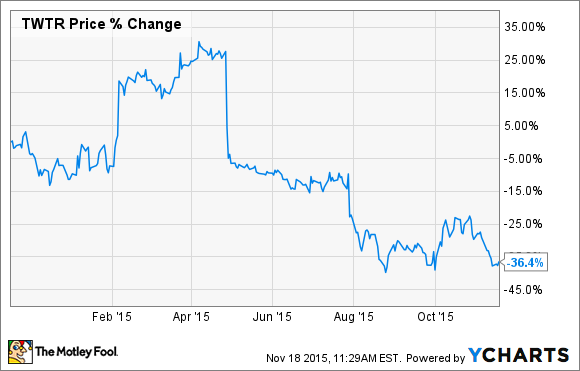
Twitter CEO Jack Dorsey. Source: Twitter
Twitter (TWTR) is a wonderful service that has done much to connect the world and democratize the flow of news and information. Unfortunately for investors, it has not been quite as successful as a stock. It currently trades near its all-time lows and well below the price it opened at on its first day of trading about two years ago. After a period of uncertainty following the departure of CEO Dick Costolo and the interim appointment of co-founder Jack Dorsey, Twitter appears to be set in the C-suites. The company recently had its first quarterly report and earnings call with Dorsey as the new chief executive and Adam Bain elevated to COO. Here are my three major takeaways, along with questions for the management team.
Revenue growth looks good. What's the problem?
Twitter often gets unfairly lumped in with Facebook, because they are both social media companies created just a few years apart. Twitter remains magnitudes smaller in terms of market capitalization, revenue, and earnings. Investors must continue to view Twitter not as a mature behemoth but rather as an upstart looking to grow users and revenue. On the revenue front, the company has been very successful. Quarterly revenue increased 58% year-over-year to $569 million.
More impressive is the source of this revenue. Mobile ads made up 86% of total ad revenue in the most recent quarter. Cracking mobile was one of the major catalysts that sprung Facebook from its post-IPO doldrums to where it is now. Dorsey and company must do a better job of demonstrating this mobile success to investors. In the latest conference call, the word "mobile" was mentioned only seven times total. This approach needs to change.
Where are the users?
From anecdotal experience, I somewhat understand the problems and the promise that Twitter has with regard to acquiring new users. As Instagram moves past 400 million monthly users and WhatsApp hurtles toward one billion, Twitter's inability to grow its total average monthly active users rapidly enough has become a major sticking point for the stock. The number grew 11% year-over-year and only 8% when excluding SMS Fast Followers.
It took me a while to see the utility of Twitter as a news aggregator, a way to initiate and cultivate professional relationships, and a source of breaking information. When I finally joined, added a list of people to follow, and began to use the service, there was no going back. The executives at Twitter must make it easier for non-users to see this utility, helping them make the decision to invest time in setting up their profiles and following lists. I can see a tipping point in the future where one small product initiative that makes this process easier will open the floodgates for new user growth. This ought to be the main priority for the development team at the company.
I know it's tech, but why so much dillution?
Many young companies use new share issuance to attract and keep talented employees. This is especially true with tech companies where many young workers are less interested in their short-term salaries and more in the potential lottery ticket that stock grants offer them. Obviously, there is a balance in using stock grants to lure talent. Diluting the company's shares by 1% to bring in a team of engineers whose work eventually leads to a 50% increase in market cap is a great move for creating shareholder value. Twitter has been diluting its existing shareholders more than other social media companies, while its share price continues to decline.
TWTR Shares Outstanding data by YCharts
Dorsey recently made headlines when he offered to return one-third of his shares, valued at around $200 million, back to the employee bonus pool for future hiring and retention. While this is certainly a magnanimous gesture, it does little to stem the overall problem. Twitter currently has over 675 million shares outstanding, and this move better serves optics and employee morale than the outside shareholder. Even if Twitter improves on revenue and monthly average user growth, it must slow down dilution. Otherwise the company will become more valuable, but the effect for individual shareholders will be sharply dampened.
What to do?
I remain bullish on this company for the long-term. Its platform is too good and its global presence too powerful for me to want to cut ties with it. With a few minor tweaks, this stock can be a multi-bagger that solidly outperforms the broad market. Dorsey and Bain are the team at the top that can get this done. If you've steered clear of Twitter up to this point, I would recommend taking a nibble at these beaten-down prices. The risk-reward profile here greatly favors those long the stock.







